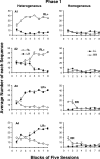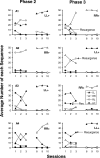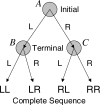Resurgence of integrated behavioral units
- PMID: 17345948
- PMCID: PMC1790883
- DOI: 10.1901/jeab.2007.55-05
Resurgence of integrated behavioral units
Abstract
Two experiments with rats examined the dynamics of well-learned response sequences when reinforcement contingencies were changed. Both experiments contained four phases, each of which reinforced a 2-response sequence of lever presses until responding was stable. The contingencies then were shifted to a new reinforced sequence until responding was again stable. Extinction-induced resurgence of previously reinforced, and then extinguished, heterogeneous response sequences was observed in all subjects in both experiments. These sequences were demonstrated to be integrated behavioral units, controlled by processes acting at the level of the entire sequence. Response-level processes were also simultaneously operative. Errors in sequence production were strongly influenced by the terminal, not the initial, response in the currently reinforced sequence, but not by the previously reinforced sequence. These studies demonstrate that sequence-level and response-level processes can operate simultaneously in integrated behavioral units. Resurgence and the development of integrated behavioral units may be dissociated; thus the observation of one does not necessarily imply the other.
Figures









References
-
- Corbit L.H, Balleine B.W. Instrumental and Pavlovian incentive processes have dissociable effects on components of a heterogeneous instrumental chain. Journal of Experimental Psychology: Animal Behavior Processes. 2003;29:99–106. - PubMed
MeSH terms
LinkOut - more resources
Full Text Sources

